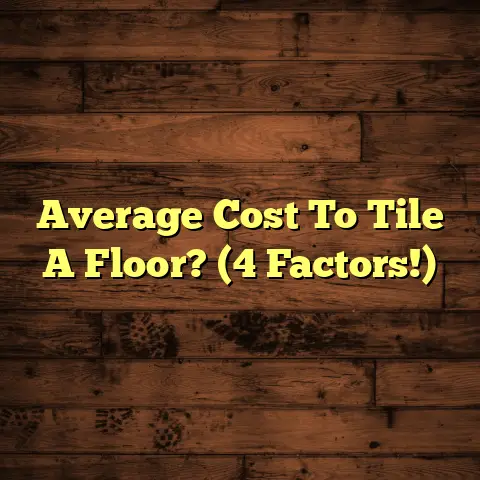Add Aggregate to Epoxy? (Critical Timing Tip!)
It’s a great question, and the answer isn’t always straightforward.
Adding aggregate can transform your epoxy floor, but messing up the timing?
That’s a recipe for disaster.
Imagine this: You’ve prepped your floor, mixed your epoxy, and you’re ready to go.
The clock is ticking.
Do you throw in the aggregate now?
Wait a bit?
What happens if you screw it up?
Trust me, I’ve been there.
I’ve learned some hard lessons along the way.
In this article, I’m going to share my experience and insights, focusing on the critical timing that can make or break your epoxy flooring project.
Let’s dive in!
1. Understanding Epoxy Flooring
So, what is epoxy flooring, anyway?
At its core, epoxy is a thermosetting polymer.
That basically means it starts as a liquid resin and hardener, and when mixed, it undergoes a chemical reaction that turns it into a solid, durable plastic.
Think of it like baking a cake.
You mix the ingredients, and heat (or in epoxy’s case, a chemical reaction) transforms it into something completely different.
Here’s a breakdown of the key components:
- Epoxy Resin: The main component, providing the base for the flooring.
- Hardener (Catalyst): This triggers the chemical reaction that cures the epoxy.
- Additives: These can include pigments for color, UV stabilizers, and, of course, aggregates.
Why is epoxy flooring so popular? Well, it’s got a lot going for it:
- Durability: Epoxy floors are tough!
They can withstand heavy foot traffic, impacts, and chemical spills. - Aesthetics: Epoxy can be customized with different colors, patterns, and finishes.
- Resistance: It’s resistant to water, oil, and many chemicals, making it ideal for garages, workshops, and commercial spaces.
Types of Aggregates:
Before we get too far, let’s touch on the types of aggregates you might consider.
We’ll go into more detail later, but here’s a quick overview:
- Quartz: A popular choice for its durability and aesthetic appeal.
- Glass Beads: Adds a decorative sparkle and can improve reflectivity.
- Rubber: Provides a softer, more slip-resistant surface, great for gyms or play areas.
2. The Role of Aggregate in Epoxy
Okay, so we know what epoxy is. But why add aggregate?
Well, aggregate isn’t just there to look pretty (although it can definitely enhance the look of your floor).
It serves several important functions:
- Improved Traction: This is a big one.
Aggregate adds texture to the surface, making it less slippery, especially when wet. - Enhanced Durability: Some aggregates, like quartz, can increase the overall strength and abrasion resistance of the epoxy.
- Aesthetic Appeal: Aggregate can add color, texture, and visual interest to your floor.
Think of it as the “spice” in your flooring recipe. - Reduced Shrinkage: Adding aggregate can help reduce shrinkage during the curing process, minimizing the risk of cracks.
Different Aggregates, Different Properties:
Let’s dig a little deeper into the different types of aggregates:
- Quartz: As I mentioned, quartz is a workhorse.
It’s incredibly durable, resistant to chemicals, and comes in a variety of colors.
I often recommend it for high-traffic areas like garages and commercial kitchens. - Glass Beads: These are purely decorative.
They add a subtle sparkle and can improve the reflectivity of the floor, making it brighter.
They are a great option for retail spaces or showrooms. - Rubber: Recycled rubber granules are an excellent choice for areas where slip resistance and impact absorption are important.
Think gyms, playgrounds, or even dog kennels. - Flakes (Mica, Vinyl, or Metallic): These are added for decorative purposes.
They come in many colors and sizes and add a unique look to the floor.
Functionality Meets Aesthetics:
The beauty of aggregate is that it allows you to combine functionality with aesthetics.
You can choose an aggregate that not only improves the performance of your floor but also enhances its visual appeal.
For example, you could use a blend of quartz and colored glass beads to create a durable and visually stunning floor for a retail space.
3. The Timing Dilemma
Alright, now we’re getting to the heart of the matter: timing.
This is where things can get tricky.
Adding aggregate to epoxy isn’t as simple as just dumping it in and hoping for the best.
The timing is crucial.
Add it too early, and it might sink to the bottom.
Add it too late, and it might not bond properly.
Too Early:
If you add the aggregate too soon, before the epoxy has started to thicken, gravity will take over.
The aggregate will sink to the bottom of the epoxy layer, leaving you with a floor that has a concentrated layer of aggregate at the bottom and a relatively aggregate-free surface.
This defeats the purpose of adding aggregate for traction and aesthetics.
Too Late:
If you wait too long, until the epoxy has already started to cure, the aggregate won’t properly bond to the surface.
It will just sit on top, loosely adhered.
This can lead to the aggregate flaking off over time, creating a messy and potentially slippery surface.
Common Mistakes:
I’ve seen contractors make these mistakes time and time again.
Here are a few of the most common:
- Not paying attention to the epoxy’s pot life: Pot life is the amount of time you have to work with the epoxy mixture before it starts to harden.
Ignoring this can lead to adding the aggregate too late. - Mixing the epoxy improperly: An unevenly mixed epoxy will cure at different rates, making it difficult to determine the right time to add the aggregate.
- Ignoring environmental conditions: Temperature and humidity can significantly affect the epoxy’s curing time.
The Goldilocks Zone:
So, what’s the sweet spot?
It’s all about finding the “Goldilocks zone” – not too early, not too late, but just right.
This is where experience comes in.
You need to develop a feel for how the epoxy is curing and learn to recognize the signs that it’s ready for the aggregate.
4. Factors Influencing the Decision to Add Aggregate
Okay, so we know that timing is important.
But what factors influence when you should add the aggregate?
Here are a few key considerations:
- Environmental Conditions: Temperature and humidity play a huge role in how quickly epoxy cures.
Warmer temperatures accelerate the curing process, while cooler temperatures slow it down.
High humidity can also affect the curing time and the adhesion of the epoxy. - Surface Preparation: A properly prepared surface is essential for good adhesion.
The surface should be clean, dry, and free of any contaminants.
If the surface isn’t properly prepared, the epoxy won’t bond properly, and the aggregate will be more likely to flake off. - Type of Epoxy: Different epoxies have different curing times and viscosities.
Some epoxies are designed to cure quickly, while others cure more slowly.
The viscosity of the epoxy will also affect how well the aggregate suspends in the mixture.
Environmental Considerations in Detail:
Let’s break down the environmental factors a bit more.
According to the Epoxy Resin Committee, the ideal temperature range for applying epoxy is between 65°F and 85°F (18°C and 29°C).
- Temperature: If it’s too cold, the epoxy will become thick and difficult to work with.
It will also take much longer to cure.
If it’s too hot, the epoxy will cure too quickly, giving you less time to add the aggregate and achieve a smooth finish. - Humidity: High humidity can cause the epoxy to blush, which is a cloudy or hazy film that forms on the surface.
This can affect the adhesion of the aggregate and the overall appearance of the floor.
Surface Preparation: The Foundation for Success:
I can’t stress this enough: surface preparation is key.
No matter how good your epoxy or aggregate is, it won’t perform properly if the surface isn’t properly prepared.
Here’s a quick rundown of the steps involved in surface preparation:
- Cleaning: Remove any dirt, dust, oil, or other contaminants from the surface.
- Grinding: Grind the surface to create a profile that the epoxy can grip onto.
- Repairing: Fill any cracks or holes in the surface.
- Priming: Apply a primer to improve adhesion and seal the surface.
Epoxy Type and Timing:
Different epoxies have different working times, so you’ll need to adjust your timing accordingly.
Refer to the manufacturer’s instructions for the specific epoxy you’re using.
For example, a fast-curing epoxy might require you to add the aggregate within 15-20 minutes of mixing, while a slow-curing epoxy might give you an hour or more.
5. Step-by-Step Process for Adding Aggregate
Okay, let’s get practical. Here’s a step-by-step guide to adding aggregate to epoxy:
- Prepare the Epoxy Mixture: Carefully measure and mix the epoxy resin and hardener according to the manufacturer’s instructions.
Use a mixing drill with a paddle attachment to ensure thorough mixing. - Assess the Epoxy’s Viscosity: This is where your experience comes in.
You want the epoxy to be thick enough to suspend the aggregate but not so thick that it’s difficult to work with.
A good test is to drip some of the epoxy onto the surface.
If it slowly flows and starts to thicken, it’s probably ready. - Add the Aggregate: Gradually add the aggregate to the epoxy, mixing continuously.
Use a clean container and avoid dumping the aggregate in all at once, as this can cause clumping. - Apply the Epoxy: Pour the epoxy onto the prepared surface and spread it evenly using a squeegee or trowel.
- Broadcast Additional Aggregate (Optional): For a heavily textured finish, you can broadcast additional aggregate onto the wet epoxy.
This is often done with decorative aggregates like flakes or glass beads. - Allow to Cure: Allow the epoxy to cure completely according to the manufacturer’s instructions.
Avoid walking on the surface or exposing it to moisture during the curing process.
Tips for Even Distribution:
Achieving an even distribution of aggregate is crucial for both aesthetics and performance.
Here are a few tips:
- Use a Seeder or Broadcast Spreader: For large areas, a seeder or broadcast spreader can help you distribute the aggregate evenly.
- Mix Thoroughly: Make sure the aggregate is thoroughly mixed into the epoxy before applying it to the floor.
- Work in Sections: Divide the floor into manageable sections and apply the epoxy and aggregate to each section separately.
- Back Roll: After applying the epoxy and aggregate, use a spiked roller to remove any air bubbles and ensure an even distribution.
6. Case Studies: Successful and Unsuccessful Applications
Let’s take a look at some real-world examples to illustrate the importance of timing.
Case Study 1: The Garage Transformation (Successful)
I worked with a homeowner who wanted to transform his garage into a functional workshop.
We chose a quartz aggregate epoxy floor for its durability and slip resistance.
We carefully prepared the surface, ensuring it was clean and properly profiled.
We then mixed the epoxy and waited for it to reach the right viscosity before adding the quartz aggregate.
We used a broadcast spreader to ensure an even distribution and back-rolled the surface to remove any air bubbles.
The result was a beautiful, durable, and slip-resistant floor that the homeowner absolutely loved.
He could work in his garage without worrying about slipping or damaging the floor.
Case Study 2: The Restaurant Disaster (Unsuccessful)
I was called in to troubleshoot a restaurant floor that had been recently installed.
The contractor had used a decorative flake epoxy, but the flakes were flaking off, creating a messy and unsafe surface.
After investigating, I discovered that the contractor had added the flakes too late, after the epoxy had already started to cure.
As a result, the flakes didn’t properly bond to the surface and were easily dislodged.
The entire floor had to be removed and reinstalled, costing the restaurant owner a significant amount of time and money.
Lessons Learned:
These case studies highlight the importance of proper timing and technique.
In the successful case, careful surface preparation, proper mixing, and timely aggregate addition resulted in a durable and aesthetically pleasing floor.
In the unsuccessful case, poor timing led to a costly and time-consuming disaster.
7. Conclusion: The Importance of Precision and Timing in Epoxy Flooring
So, there you have it.
Adding aggregate to epoxy can be a great way to enhance the performance and appearance of your floor.
But it’s crucial to understand the importance of timing.
Remember these key points:
- Timing is everything: Add the aggregate too early, and it will sink.
Add it too late, and it won’t bond. - Consider environmental conditions: Temperature and humidity can affect the epoxy’s curing time.
- Prepare the surface properly: A clean, dry, and properly profiled surface is essential for good adhesion.
- Choose the right epoxy: Different epoxies have different curing times and viscosities.
- Mix thoroughly: Ensure the epoxy and aggregate are thoroughly mixed before applying to the floor.
Adding aggregate to epoxy isn’t rocket science, but it does require attention to detail and a good understanding of the materials you’re working with.
With the right knowledge and technique, you can create a beautiful and durable epoxy floor that will last for years to come.
Now, get out there and create some amazing floors!





